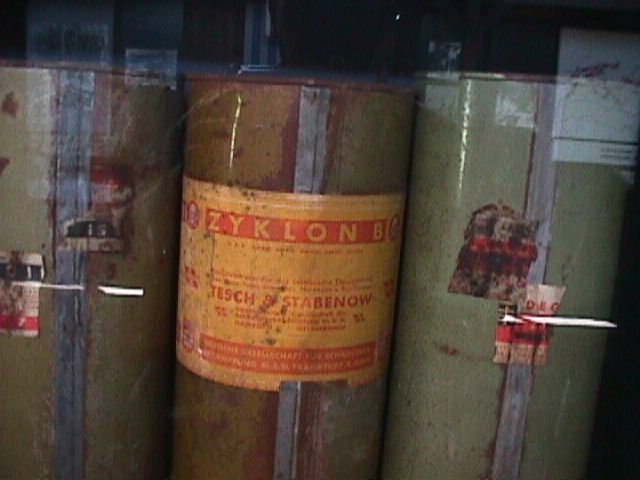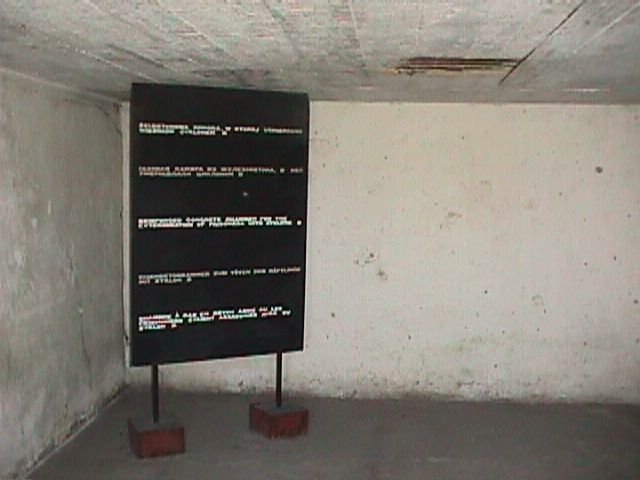 |
 |
Majdanek
Of the six death camps built by the Nazis in Poland to eliminate the Jews and other "undesireables," the least is known about Majdanek (also called Maidanek), despite it being in nearly pristine condition when the Soviets arrived there immediately following the Nazi evacuation of the camp in July 1944. While the wooden structure surrounding them had been destroyed, the crematoria had not been destroyed, and the rest of the camp was intact, including a mind-numbing amount of human remains on the premises, which would be exceeded only when the Soviets subsequently arrived at Treblinka and Auschwitz.
The camp was established by Reichsführer-SS Heinrich Himmler almost immediately after the Nazi invasion of the Soviet Union and its occupied territories in June 1941. (He had ordered it built literally one day before the invasion on June 22, 1941.) However, it was not founded as a concentration camp, but rather as a Prisoner of War (POW) camp, built to hold up to 50,000 POWs, mostly from the Soviet Union. (It is the only one of the death camps in which some American soldiers were also held as POWs.) It was given the name Kriegsgefangenenlager der Waffen SS in Lublin (Waffen-SS POW Camp in Lublin). The local Polish population dubbed the camp Majdanek, basing the name on Majdan Tatarski, the suburb of Lublin in which the camp was situated. (Unlike other death camps in Poland, Majdanek was in plain view of the Lublin citizens, probably because it was originally founded as a POW camp and not a death camp.)
Two thousand Soviet POWs were used to build the original camp, under the orders of SS and Police Leader for Lublin Odilo Globocnik and the camp's first commandant, Karl Otto Koch (husband of the infamous Ilse Koch), who was transferred there from Buchenwald because of his wife's indiscretions in September 1941. Koch's tenure at Majdanek was short (he left in July 1942, before the camp's extermination facilities were operational, probably because of continued criminal activity while at Majdanek, for which he was executed by the SS in April 1945), and he was replaced by Max Kögel, whose tenure (until October 1942 and then transferred to Flossenburg) was even shorter. Kögel's replacement, Hermann Florstedt, was transferred there from Sachsenhausen, but, like his predecessor Koch, ran afoul of the SS, and Majdanek was run by interim commandants Markus Melzer and Martin Weiss until May 1944, when the camp's final commandant, Arthur Liebehenschel, who had been Rudolf Höss's replacement at Auschwitz, oversaw Majdanek until its liquidation.
With the beginning of Aktion Reinhard in 1942, Majdanek was transformed into KZ Lublin and its mission extended to include exterminations. Ironically, though Lublin lay in the territory of the Generalgouvernment, no camp had been established in the area previously, and most of the Jews from the nearby Lublin Ghetto were deported to the death camp at Belzec, since Majdanek was still a POW camp in early 1942. Jews began arriving at the camp in March 1942, however. Some 25,000 Jews were among the first deportees to Majdanek -- 10,000 deported from Slovakia and 14,000 from the Reichsprotektorat of Bohemia and Moravia via the "old age camp" at Terezin. The Jewish deportees to Majdanek would eventually consist of citizens of the Netherlands, Belgium, France, Greece, and the remaining Jews in Lublin and the Bialystok district.
A key incident in the history of Majdanek is the daring escape attempt by around 200 Soviet POWs on July 14, 1942. About half of the escapees were never captured and went back to their units to fight as partisans until the end of the war. This event parallels similar acts of resistance in the death camps: there were successful prisoner breaks from both Treblinka and Sobibor, and the Sonderkommando uprising at Auschwitz successfully destroyed a Krema building.
Though mass executions by poison gas would not begin at Majdanek until September 24, 1942, the SS began preparing in the summer, requisitioning nearly a ton Zyklon-B, which was already under use at Auschwitz-Birkenau, in late July 1942. The first gassings were conducted in makeshift gas chambers while the camp was being expanded. (The order to do so was given a mere two days later.) Among the first Jews executed were the remaining Jews in the Lublin ghetto, who were moved to Majdanek in November 1942 when the ghetto was liquidated.
The expansion of Majdanek was extensive. By the fall of 1943, when it was completed, the camp was divided into six sections: (1) a women's camp; (2) a field hospital, mainly for the use of Soviet collaborators; (3) a section for male Polish political prisoners and Jews from Warsaw and Bialstok; (4) a section for more male political prisoners, as well as Soviet POWs and civilian hostages, who were routinely killed in reprisal actions; (5) a men's hospital; and (6) a never-completed area that was intended to include new barracks for the SS, factories (Majdanek was a labor camp as well as an extermination camp), and more gas chambers and crematoria.
Gassings were not common at Majdanek until the fall of 1943. However, murder of Jews and other prisoners at the camp had already begun and continued apace through the winter of 1942-1943 and into the spring. Most of these executions were carried out by gunfire, with the rest of the deaths attributable to neglect, overwork, and disease. Some 16,000 ethnic Poles arrived in the camp at the end of June 1943 from the Zamosc region, refugees from the ultimately failed experiment in ethnic cleansing undertaken by Himmler and Globocnik in Zamosc to create a German enclave. While over 100,000 Poles were deported from Zamosc, most were taken to Auschwitz and other camps, though they suffered the same fate there as they did at Majdanek: a large number were murdered.
With the camp sufficiently expanded by fall, regular selections similar to those done at Auschwitz began at Majdanek. In the first selection, 400 Jews were chosen as unfit for work and gassed on September 2, 1943. Selections then became routine, with both Jews and non-Jews selected and now gassed in the newer facilities.
The reaction to the aforementioned uprising at Sobibor was Aktion Erntefest (Operation Harvest Festival), conducted in early November 1943. Largely a reprisal, it involved the murder of Jews in several camps, including Majdanek. On November 3, 1943, in several camps, over 40,000 Jews were killed – some 18,000 of them having been taken out of Majdanek, shot, and buried in ditches inside the perimeter of the camp. This constituted the remainder of the Jewish population of the camp. From this point until the camp’s liquidation, the camp would continue to function as a POW and labor camp for non-Jews, with occasional exterminations of "unfit laborers" from these groups.
By the spring of 1944, the Soviet counteroffensive was so successful that Majdanek was ordered evacuated. However, the evacuation, which began in March, was ordered stopped in mid-April, as the counteroffensive seemed to be faltering. Within a few weeks, though, the camp was bombarded by the Soviet Air Force, with the SS barracks and some of the crematoria being destroyed. The evacuation was ordered continued and by July 22, 1944, was completed. The Red Army entered the camp a day later, finding only 500 infirm inmates left in the camp. Within a month, the Soviets were inviting the press into the camp to show evidence of Nazi war crimes. In the fall of 2005, an excavation crew found several personal valuables that had been buried by Jewish victims before they were gassed.
The death toll at Majdanek is one of the remaining mysteries of the Holocaust. Raul Hilberg, author of The Destruction of the European Jews, estimated the death toll at 50,000, but he was only counting Jewish victims of each death camp in his study. By contrast, the camp's museum, the Simon Wiesenthal Center, and the U.S. Holocaust Memorial Museum agree that over 300,000 people died at Majdanek. The plurality of the inmates were Jews (40 percent), but there were also high numbers of Poles, Soviets, French, and Dutch prisoners, as well as Jews, political prisoners, and criminals from Germany, Austria, and Italy. Most likely, Hilberg's figure is correct, and the remaining 250,000 or more victims of the camp were not Jewish, making it an exception to the other five death camps.
However, it should be noted that the primary victims of the gas chambers of Majdanek were Jewish. The other inmates tended to die of the harsh conditions in the camp. While this is certainly no less murder, it does point to the mission of Majdanek, in part, being a vital part of the Final Solution that the Nazis unleashed on Europe’s Jews.
Images
The first image shows a 1.5 kilogram cannister of Zyklon-B.
The second shows a gas chamber in the Maidanek camp. Zyklon-B was dropped into the chamber after the victims were locked in it, killing them within minutes.
The third shows some of the hundreds of thousands of shoes of the victims of the Maidanek camp.
Resources
Despite its relative obscurity, there is a fair amount of scholarship in circulation on the Majdanek camp:
Murowska-Gryn, and Edward Gryn. Majdanek. Lublin: Panstwowe Muzeum Majdanku, 1984.
Marszalek, Józef. Majdanek: The Concentration Camp in Lublin. Warsaw: Interpress, 1986.
Samek, Tomasz, Edward Balawejder, Tomasz Kranz, et al. In the Middle of Europe: Konzentrationslager Majdanek. Münster: Stadtmuseum Münster, 2001.
Rajca, Czeslaw, and Anna Wisniewska. Majdanek: Concentration Camp. Lubin: Panstwowe Muzeum Majdanku, 1983.
Strigler, Mordechai. Majdanek. Buenos Aires: Union Central Israelita Polaca enla Argentina, 1947.
And, on the liberation of Majdanek and other camps by the Red Army:
Pavlenko, B.N., K.M. Simonov, and Mikhail Trakhman. Liberation. Moscow: Progress Publishers, 1974.
Last modified: January 22, 2006
Technical/administrative contact: webmaster@holocaust-history.org


